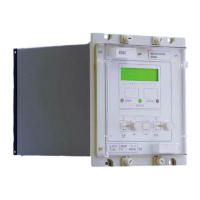VCG202/EN M/H11
Technical
Note: Make sure the new password has been written down before it is
entered and that the password being entered agrees with the
written copy before accepting it. If the new password is not
entered correctly you may be denied access in the future. If the
password is lost a unique back-up password for that relay can be
provided from the factory, or certain agents, if the serial number of
the product is quoted.
3.4.8 Restoration of password protection
Password protection is reinstated when the alarm LED stops flashing, this will occur
fifteen minutes after the last key press. To restore the password protection without
waiting for the fifteen minute time-out, select the password cell and hold the reset key [0]
depressed for one second. The alarm LED will cease to flash to indicate the password
protection is restored. Password protection is also restored when the default display is
selected (see Chapter 3.3.1).
3.4.9 Entering text
Enter the setting mode as described in Chapter 3.4.2 and move the cursor with the [F]
key to where the text is to be entered or changed. Then using the [+] and [–] keys, select
the character to be displayed. The [F] key may then be used to move the cursor to the
position of the next character and so on. Follow the instructions in Chapter 3.4.3 to exit
from the setting change.
3.4.10 Changing function links
Select the page heading required and step down to the function links “SD Links”,
“Function Links”, or LOG Links” and press either the [+] or [–] to put the relay in a setting
change mode. A cursor will flash on the bottom line at the extreme left position. This is
link “F”; as indicated by the character printed on the front plate under the display.
Press the [F] key to step along the row of links, one link at a time, until some text appears
on the top line that describes the function of a link. The [+] key will change the link to a
“1” to select the function and the [–] key will change it to a “0” to deselect it. Follow the
instructions in Chapter 3.4.3 to exit from the setting change.
Not all links can be set, some being factory selected and locked. The links that are
locked in this way are usually those for functions that are not supported by a particular
relay, when they will be set to “0”. Merely moving the cursor past a link position does not
change it in any way.
3.4.11 Changing setting values
Move through the menu until the cell that is to be edited is displayed. Press the [+] or [–]
key to put the relay into the setting change mode. A cursor will flash in the extreme left
hand position on the bottom line of the display to indicate that the relay is ready to have
the setting changed. The value will be incremented in single steps by each momentary
press of the [+] key, or if the [+] key is held down the value will be incremented with
increasing rapidity until the key is released. Similarly, the [–] key can be used to
decrement the value. Follow the instructions in Chapter 3.4.3 to exit from the setting
change.
Note: When entering CT RATIO or VT RATIO the overall ratio should be
entered, i.e. 2000/5A CT has an overall ratio of 400:1. With rated
current applied the relay will display 5A when CT RATIO has the
default value of 1:1 and when the ratio is set to 400:1 the displayed
value will be 400 x 5 = 2000A.
3.4.12 Setting communication address
The communication address will be set to 255, the global address to all relays on the
network, when the relay is first supplied. Reply messages are not issued from any relay
for a global command, because they would all respond at the same time and result in
contention on the bus. Setting the address to 255 will ensure that when first connected to
the network they will not interfere with communications on existing installations. The
communication address can be manually set by selecting the appropriate cell for the
SYSTEM DATA column, entering the setting mode as described in Chapter 3.4.2 and

